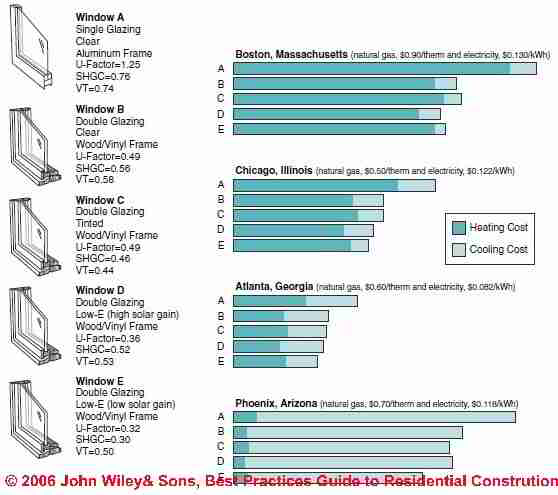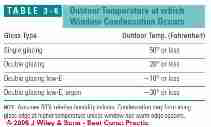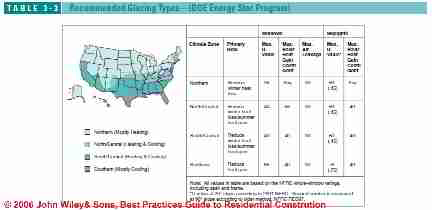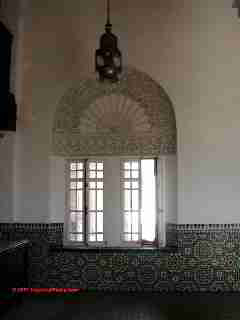 Window Efficiency & Choices by Climate
Window Efficiency & Choices by Climate
- POST a QUESTION or COMMENT about how & when to choose various types of energy efficient windows: what energy efficienct windows are needed ?
Window glazing recommendations for different climates:
This article continues our discussion of window energy efficiency with an explanation of window choices matched to climate, use of window shading to control solar gain, the solar heat gain coefficient of windows, visible transmittance ratings for windows, window air leaks, and fading due to UV light from windows or skylights.
InspectAPedia tolerates no conflicts of interest. We have no relationship with advertisers, products, or services discussed at this website.
- Daniel Friedman, Publisher/Editor/Author - See WHO ARE WE?
Choosing Window Glazing Based on Climate
In this article series we discuss the selection and installation of windows and doors, following best construction and design practices for building lighting and ventilation, with attention to the impact on building heating and cooling costs, indoor air quality, and comfort of occupants. We review the proper installation details for windows and doors, and we compare the durability of different window and door materials and types.
Article Contents
As detailed in Best Practices Guide to Residential Construction (Steve Bliss, J Wiley & Sons) Chapter 3, BEST PRACTICES GUIDE: WINDOWS & DOORS:
Due to its significantly lower U-value, low-E glass outperforms standard double glazing in all climates. However, which type of low-E glazing is optimal for a building depends on several factors, including the heating load, cooling load, and orientation of the glass. In general, the windows with the lowest U-values will yield the greatest savings in cold climates, while windows with the lowest solar heat gain will yield the greatest savings in hot climates.
Performance comparisons of different window types in different climates, based on computer modeling, are shown in Figure 3-10 above.
Also see SUNGAIN, FILMS, LOW-E GLASS.
Some window manufacturers market different glazing types in different parts of the country and may be able to provide different glazing types by special order. General recommendations from the EPA’s Energy Star program are shown in Table 3-3 below.
- Window Glazing Recommendations for Cold climates. In climates dominated by heating
loads, select a window with a low U-value (high
R-value). Windows with high solar gain will slightly
favor winter performance and windows with low solar
gain will slightly favor summer performance, but
annual energy costs are determined primarily by the
U-value.
Two exceptions to this are passive solar homes, which should use high-solar-gain glass, and homes with a lot of west-facing glass, which should use low-solar-gain spectrally-selective (Spectrally Selective Window Glazing) glass. - Window Glazing Recommendations for Mixed climates. Spectrally selective glass or low-E glass
(SUNGAIN, FILMS, LOW-E GLASS) with moderate solar gains are good choices in mixed
climates.
The greater the cooling load, the more important a low solar-heat-gain factor will be. However, the differences in annual fuel bills between using high, low, or moderate solar-heat gain glass in these climates will usually be small. Other issues like overall U-value, UV light transmission, cost, and durability might be the more important factors in choosing a window.
- Window Glazing Recommendations for Hot climates. In climates dominated by cooling
loads, choose a glazing type with low solar-heat gain.
Spectrally selective coatings provide an ideal combination of high R-values, high visible-light transmission, and low solar-heat gain. UV radiation, which causes fading, is also cut significantly.
Spectrally selective glass is a big improvement over tinted glass, which blocks solar gains, but also obscures views and creates glare and reflections when viewed from outside.
Our photo of a warm-climate window (above, left) is in Rabat, Morocco, a climate that ranges from warm to hot (-DF).
Solar-Heat-Gain Coefficient Rating for Windows: SHGC
A window with an SHGC of .70 captures about 70% of the available solar energy falling on the window. Clear double glazing has an SHGC of about .75 versus .60 to .70 for standard low-E and about .40 for spectrally selective low- E. Which type of glazing is optimal for a given project depends on the climate, summer and winter fuels costs, and how glass is used in the house design.
[Click to enlarge any image]

- Low SHGC. Low-solar-gain glass blocks unwanted
solar gain and provides significant savings in both
peak and annual cooling loads in hot climates. For
example, switching from clear double glass to low-
SHGC glazing can reduce air-conditioning bills by
15 to 20% in a typical home in Phoenix or Miami
See Figure 3-10 above.
Spectrally selective glass , introduced in the 1990s, combines very low solar gains with high visible light transmittance and high R-values (up to R-4 with gas fill). While this yields the greatest savings in hot climates, it is also a good choice in any climate with significant cooling loads or large amounts of un shaded west-facing glass.
See Spectrally Selective Window Glazing - Moderate SHGC. In northern cities like Boston or Chicago or mixed climates with more-or-less equal heating and cooling costs, moderate-gain glass is a reasonable choice, balancing moderate solar gains in winter with moderate blocking of solar gains in summer.
- High SHGC. High solar-heat-gain glass is a good
choice in cold climate homes with enough south glass
to take advantage of passive solar gain, called “sun
tempering.” Savings on winter heating bills will be
partially offset by the increased cooling load in
summer, however.
To avoid overheating, south-facing glass should range from 4 to 7% of the total floor area (avoid sloped glass, which tends to overheat in summer and fall).With south glass in excess of 7% of floor area, thermal mass may be needed to prevent daytime overheating and to store heat for nighttime use.
A designer with expertise in passive solar can help determine the right amounts of glass and thermal mass.
Visible Transmittance Ratings for Windows
People install windows primarily for daylighting and views, so the higher the percentage of visible light transmitted (VT), the better. Clear double-glazing has a VT of about 80% (see Table 3-4, below). With hard-coat low-E, that figure drops to 75%, and down to about 70% with the new spectrally selective coatings.
See Spectrally Selective Low-E Windows.

All low-E coatings reduce visible light transmittance to some extent and some may appear slightly tinted or more reflective under certain light conditions. The new spectrally selective glazings are fairly color-neutral, but they may appear slightly darker compared to clear glass.
[Click to enlarge any image]
In general, most people do not notice tinting until the VT of the glazing falls below about 60%. The visible light transmittance ratings listed on NFRC window labels can be confusing since they include the sash and frame, not just the glass.
The VT for the glass only should be available from the window or glazing manufacturer upon request. Beyond the numbers, it is always a good idea to examine a sample of the glass before purchasing. View the glass from both outdoors and indoors under different light conditions to check for tint and glare.
Also see SUNGAIN, FILMS, LOW-E GLASS. And see Skylight Energy Efficiency.
Window Air Leakage
In older homes, leaky windows contributed significantly to heating loads (less to cooling loads), and the drafts made occupants feel cold despite the thermostat setting. While windows built today are, in general, much tighter, the effect of air leakage can still be significant on cold, windy days, particularly on windows with direct wind exposure.
Most windows today are built with a leakage rate of .30 cfm/sq ft of glass area or less, the minimum allowed under the AAMA/NWWDA standard. The best windows have leakage rates near .10 cfm/sq ft.
Windows with compression seals, such as casements and awnings, tend to be tighter than windows with sliding seals, such as double-hungs and sliders. Also slide-by weather-stripping is more prone to wear out over time and more likely to be breached by high winds that cause the window to flex.
With any weather-stripping system, look for long-lasting materials such as EPDM and silicone and heavy-duty construction that can withstand years of use and exposure to water, freezing and burning temperatures, and UV radiation.
Fading of Interior Carpets & Furnishings due to UV Light
Most interior materials, including fabrics, carpeting, paint, and artworks, fade from exposure to sunlight. Although the most potent effect is from ultraviolet (UV) radiation, research has shown that the shorter wavelengths of the visible light spectrum also cause fading.
To account for the relative effects of both UV and visible light on typical materials, researchers have developed an approach called “damage-weighted transmittance” (T-dw), which was recently standardized by the International Standards Association (ISO/CIE 89/3).
Typical T-dw numbers range from about 60% for clear double glazing to about 30% for spectrally selective glazing.
See “UV Light Transmittance,” Table 3-4 above and see Spectrally Selective Low-E Windows.
Lower ratings are available with triple glazing or tinted glass, primarily used in commercial construction. Low numbers for UV transmittance and T-dw indicate less fading potential, but some fading will still occur. The best approach with valuable rugs, artworks, and other light sensitive furnishings is to place them in areas with minimal exposure to windows or to use shades or draperies that substantially cut light transmission.
Also see SOLAR SHADES & SUNSCREENS.
Condensation Resistance Ratings for Windows: Window Condensation or "Sweating"
Details about this topic are found at CONDENSATION on WINDOWS & SKYLIGHTS. Excerpts are below.
 To rate a window’s resistance to condensation, NFRC recently
developed a method that evaluates the window’s
frame, glass, and glass edge at a standardized set of temperature
and humidity conditions.
To rate a window’s resistance to condensation, NFRC recently
developed a method that evaluates the window’s
frame, glass, and glass edge at a standardized set of temperature
and humidity conditions.
Based on the coldest part of the window assembly, it is assigned a rating from 1 to 100.
The higher the rating, the better the window is at resisting condensation, but the rating doesn’t predict condensation under specific conditions. The voluntary minimum for a “thermally improved window” under the AAMA/NWWDA standard is 35.
The best protection against condensation is low-E glass with gas fill, combined with warm-edge spacers and a nonmetallic window frame, such as wood, vinyl, fiberglass, or one of the newer composites.
Table 3-6 (below) provides a general guide to when condensation is likely to form on different types of glazing. Without warm-edge spacers, condensation will occur at window edges first.

[Click to enlarge any image]
Also See CONDENSATION or SWEATING PIPES, TANKS
and DEW POINT TABLE - CONDENSATION POINT GUIDE
as well as HUMIDITY LEVEL TARGET.)
[Click to enlarge any image]
Window Orientation - Which Way a Window Faces
Which way a window faces has a big impact on its contribution to comfort, heating and cooling loads, and daylighting.
- West-facing glass is the most problematic, because in
summer the afternoon sun shines directly on the glass,
causing glare and overheating the house already
warmed by increasing afternoon temperatures. Provide
shade with plantings or light-colored shades (exterior
shades are most effective). Overhangs do not help
much due to the low angle of the sun. Also
see SOLAR SHADES & SUNSCREENS. - South-facing glass (within 30 degrees of true south) gets direct sun exposure in the winter when it is desirable, at least in climates with significant winter heating loads. In summer, the sun is high on the south side, moderating the solar gain. Also, it is easier to block the high summer sun with appropriately sized overhangs or awnings. South-facing glass should not exceed 7% of the building floor area, unless thermal mass is used.
- East-facing glass provides desirable morning light and modest solar gains on cold winter mornings. Too much un shaded east glass, however, can cause overheating in summer.
- North-facing glass provides diffused light that is free of glare and solar gains, which is ideal for daylighting and is sought after by artists for its consistent color and intensity.
In most cases, one type of glazing can work on all sides of the house. In houses with large amounts of west glass, however, it makes sense to use tinted or spectrally selective glass at least on the west face to reject the summer sun. This will dramatically improve comfort and reduce both peak and annual cooling loads.
If the house is also designed to take advantage of passive solar heating, high-heat-gain windows are preferable on the south face. Mixing glazing types can get tricky, however, and should be handled by an experienced solar designer. One caution, also, is that the slightly different tints of the two glazing types might be objectionable to some clients.
Industry Associations for Windows & Doors
American Architectural Manufacturers Association (AAMA) www.aamanet.org
Efficient Windows Collaborative www.efficientwindows.org
National Fenestration Rating Council (NFRC) www.nfrc.org Sustainable by Design www.susdesign.com
Shareware calculators for sun angles, solar heat gain, and shading
Window and Door Manufacturers Association (WDMA) www.wdma.com
This article includes excerpts or adaptations from Best Practices Guide to Residential Construction (Steve Bliss, J Wiley & Sons) , by Steven Bliss, courtesy of Wiley & Sons.
- - Adapted and paraphrased, edited, and supplemented, with permission from Best Practices Guide to Residential Construction (Steve Bliss, J Wiley & Sons) .
...
Continue reading at WINDOW EFFICIENCY FEATURES & RATINGS or select a topic from the closely-related articles below, or see the complete ARTICLE INDEX.
Or see
WINDOW / DOOR ENERGY EFFICIENT, DOE
WINDOWS & DOORS - home
Suggested citation for this web page
WINDOW GLAZING BASED on CLIMATE at InspectApedia.com - online encyclopedia of building & environmental inspection, testing, diagnosis, repair, & problem prevention advice.
Or see this
INDEX to RELATED ARTICLES: ARTICLE INDEX to DOORS & WINDOWS
Or use the SEARCH BOX found below to Ask a Question or Search InspectApedia
Ask a Question or Search InspectApedia
Questions & answers or comments about how & when to choose various types of energy efficient windows: what energy efficienct windows are needed ?.
Try the search box just below, or if you prefer, post a question or comment in the Comments box below and we will respond promptly.
Search the InspectApedia website
Note: appearance of your Comment below may be delayed: if your comment contains an image, photograph, web link, or text that looks to the software as if it might be a web link, your posting will appear after it has been approved by a moderator. Apologies for the delay.
Only one image can be added per comment but you can post as many comments, and therefore images, as you like.
You will not receive a notification when a response to your question has been posted.
Please bookmark this page to make it easy for you to check back for our response.
IF above you see "Comment Form is loading comments..." then COMMENT BOX - countable.ca / bawkbox.com IS NOT WORKING.
In any case you are welcome to send an email directly to us at InspectApedia.com at editor@inspectApedia.com
We'll reply to you directly. Please help us help you by noting, in your email, the URL of the InspectApedia page where you wanted to comment.
Citations & References
In addition to any citations in the article above, a full list is available on request.
- Basic Housing Inspection, US DHEW, S 352.75 U48, p.144, out of print, but is available in most state libraries; New York State version, ca 1955, source of our window parts and window repair sketches.
- Best Practices Guide to Residential Construction, by Steven Bliss. John Wiley & Sons, 2006. ISBN-10: 0471648361, ISBN-13: 978-0471648369, Hardcover: 320 pages, available from Amazon.com and also Wiley.com. See our book review of this publication.
- "Solar Heat Gain & Windows, the facts about", NFRC, National Fenestration Rating Council, January 2005, NFRC website: www.nfrc.org retrieved 12/4/2010, original source: http://www.nfrc.org/documents/SolarHeatGain.pdf.
- Our recommended books about building & mechanical systems design, inspection, problem diagnosis, and repair, and about indoor environment and IAQ testing, diagnosis, and cleanup are at the InspectAPedia Bookstore. Also see our Book Reviews - InspectAPedia.
- Decks and Porches, the JLC Guide to, Best Practices for Outdoor Spaces, Steve Bliss (Editor), The Journal of Light Construction, Williston VT, 2010 ISBN 10: 1-928580-42-4, ISBN 13: 978-1-928580-42-3, available from Amazon.com
- The Journal of Light Construction has generously given reprint permission to InspectAPedia.com for adaptations, quotations, or reproductions used at this website. All rights and contents of the JLC material are ©Journal of Light Construction and may not be reproduced in any form.
- In addition to citations & references found in this article, see the research citations given at the end of the related articles found at our suggested
CONTINUE READING or RECOMMENDED ARTICLES.
- Carson, Dunlop & Associates Ltd., 120 Carlton Street Suite 407, Toronto ON M5A 4K2. Tel: (416) 964-9415 1-800-268-7070 Email: info@carsondunlop.com. Alan Carson is a past president of ASHI, the American Society of Home Inspectors.
Thanks to Alan Carson and Bob Dunlop, for permission for InspectAPedia to use text excerpts from The HOME REFERENCE BOOK - the Encyclopedia of Homes and to use illustrations from The ILLUSTRATED HOME .
Carson Dunlop Associates provides extensive home inspection education and report writing material. In gratitude we provide links to tsome Carson Dunlop Associates products and services.



